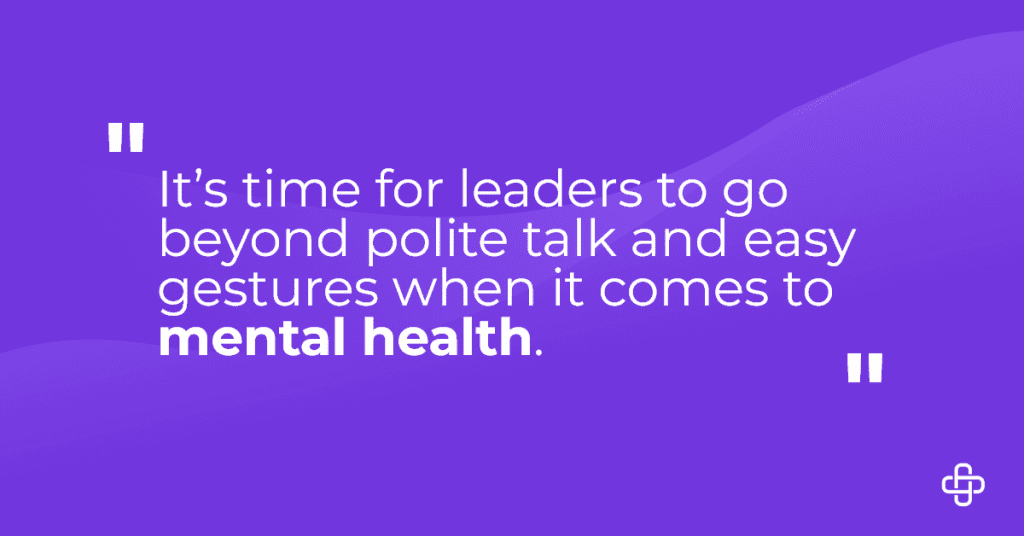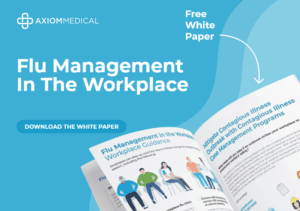It’s easy to neglect mental health in industries where getting stuff done is the top priority. But the growing rates of depression and suicide leave employers with no choice but to take early and decisive action.

That’s right, it’s time for leaders to go beyond polite talk and easy gestures when it comes to mental health. Just like how proper use of PPE on the job site can mean the difference between life and death, so can regular mental health checks.
Let’s review 7 ways you can get serious about mental health below:
1. Address Industry-Specific Stressors
Some challenges in your industry are impossible for outsiders to fully grasp. It’s up to those within the field to address the unique, isolating stressors that come with the job.
Take welding, for example: workers endure physical demands like intense heat, repetitive motions, and confined spaces, which amplify psychological pressures such as maintaining precision under stress, meeting tight deadlines, and coping with isolation caused by safety gear.
What are the specific stressors in your industry?
To uncover these, leaders should:
- Schedule regular debriefs during major projects to identify and discuss evolving stressors.
- Conduct anonymous surveys to gather honest feedback on physical and mental challenges.
- Observe workflows to pinpoint stressors that may not be openly communicated.
By understanding these stressors, you can develop tailored mental health solutions that truly support your teams.
2. Leverage Technology to Support Wellness
Technology is transforming workplace mental health by breaking down barriers and offering new ways to address challenges. In environments where stoicism has traditionally been the norm and vulnerability can feel risky, workers now have tools to express concerns anonymously or validate their mental health struggles with data-driven insights.
Here are a few ways technology is making an impact:
- Virtual counseling offers privacy and flexibility for those hesitant to speak up.
- Pulse surveys give real-time insight into workforce sentiment.
- Wearables like fatigue sensors can catch physical burnout before it spirals into mental strain.
When used thoughtfully, technology can support mental health by helping workers monitor their own well-being while allowing leaders with insights to provide better support.
3. Prioritize Leadership Accountability
Leadership sets the tone for what is acceptable. If they de-stigmatize mental health issues, preventing and treating them will become much easier.
How can leaders demonstrate that they care?
- Discuss wellness during monthly team check-ins.
- Attend outside mental health trainings and share your takeaways with the team.
- Set goals tied to mental health resource use and awareness.
- Establish internal accountability systems by documenting leaders’ contributions to mental health initiatives as part of their formal performance evaluations.
- Advocate for better mental health policies and identify areas for improvement.
When employees see their leaders prioritizing these issues collectively, a ripple effect of trust is created across the workplace.
4. Redesign Depressing Environments
Ergonomics is an often-overlooked factor in mental wellness. Workers who spend their shifts in sprawling, open settings like warehouses, shipyards, or production facilities may not have a safe, quiet place to decompress. Intentionally redesigning the workspace to incorporate areas for moments of privacy, safety, and relaxation can support mental health needs.
Here are some ways to curb depression through environmental tweaks:
- Create private decompression zones with soft seating and calming materials like magazines or calming music.
- Use modular rest pods on job sites with shade, basic first aid, and hydration.
- Enhance break areas with natural light, greenery, and encouraging signage.
A little can go a long way. Even small touches can soothe employees if they’re feeling overwhelmed or need to collect their thoughts.
5. Use Peer-Led Initiatives
Many workers feel more comfortable sharing struggles with peers rather than supervisors. Build upon this natural dynamic by empowering teams to lead wellness programs or peer support networks.
- Encourage informal pre/post-shift huddles where teams can talk openly before or after shifts.
- Nominate and train mental health advocates within departments.
- Provide resources and authority so advocates can provide basic support when someone’s struggling—not just observe.
Leadership should ensure these informal avenues are backed with the proper tools, so their impact feels purposeful and not performative.
6. Use Data to Identify Mental Health Issues
Data-driven approaches will help leaders analyze key performance indicators (KPIs) tied to mental wellness (e.g., absence rates, turnover metrics, or incidents tied to fatigue). Honest evaluations through this lens can identify trends and get the ball rolling on actions that prevent depression and suicide.
For example, if quarterly metrics suggest rising absenteeism during peak project periods, this insight warrants deeper analysis.
Leaders could ask:
- Is burnout to blame? Look for signs like increased errors, missed deadlines, or disengagement.
- If it is, are employees hesitant to express concerns directly? Consider whether there’s a lack of trust or fear of repercussions that might prevent open communication.
- Should we adjust workloads or timelines? Explore whether expectations during peak periods are realistic and if additional resources or flexibility could ease the strain.
Recognizing these patterns allow leaders to periodically update policies based on worker feedback. Furthermore, seeing these changes take place will reinforce the idea that workers’ voices hold weight.
7. End With Action
To deepen this discussion and learn practical, field-tested strategies, don’t miss Axiom’s upcoming webinar, “Workplace Suicide Prevention: Real Stories, Real Solutions.” Hear from Sarah Hathaway, Axiom’s Director of Behavioral Health and EAM, alongside Arcxis Chief HR Officer, Rod Branch. Through their expertise and firsthand stories about combatting depression and suicide in the workplace, you’ll gain clarity on how workplace culture shifts can transform lives.










